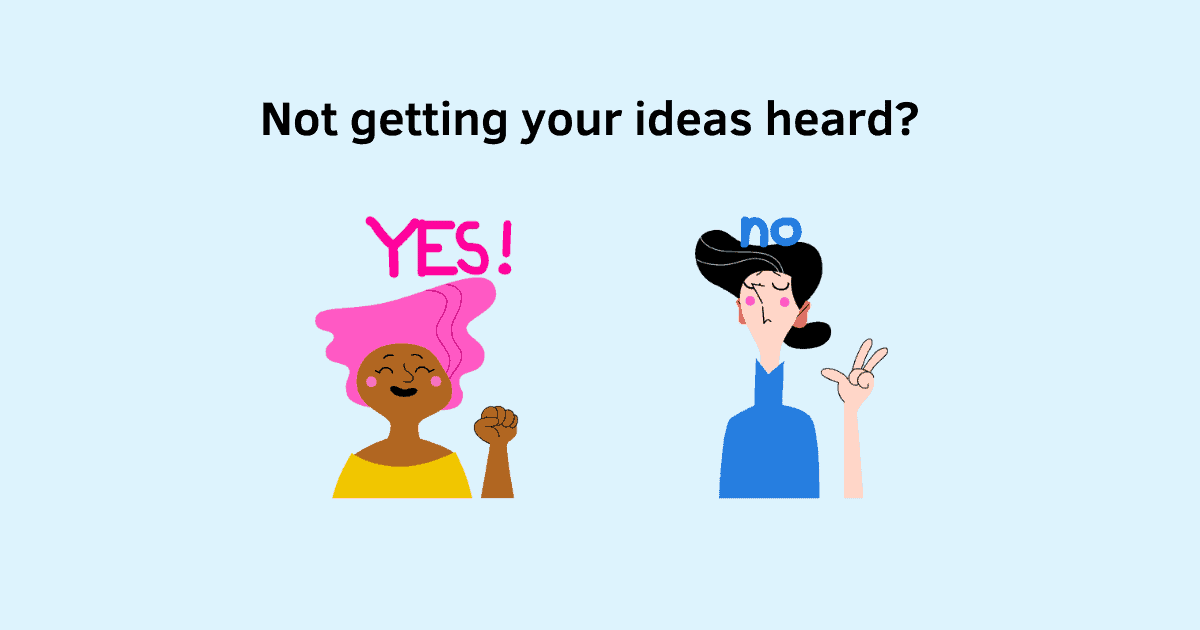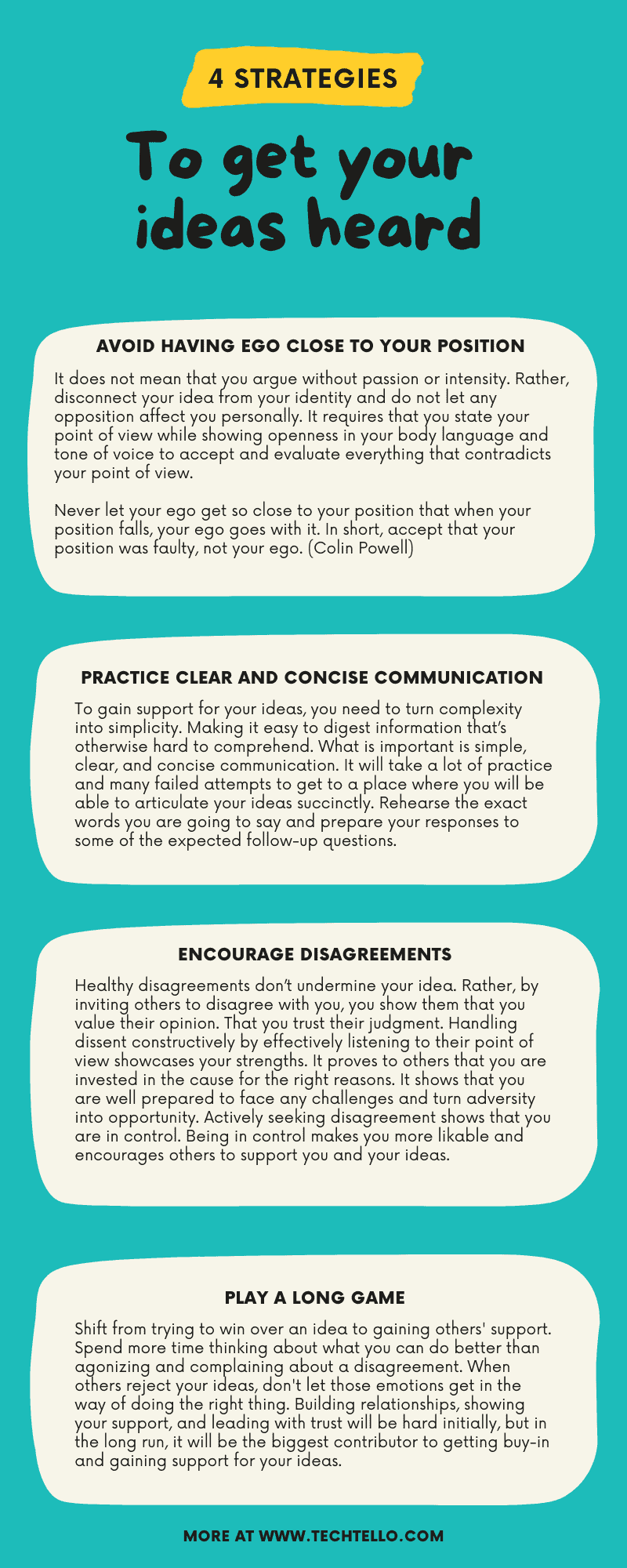Not Getting Your Ideas Heard? Here’s How to Gain Support for Your Ideas

Most of us think our ideas are great and rally them around with the expectation to turn them into something big, drive a huge impact for our organization and earn the reward and the recognition that our idea rightly deserves.
It’s not uncommon then to expect others to fall in love with our ideas, champion our cause as their own cause and show the same passion and energy that we bring to the table.
However, our fantasy soon hits a dose of reality as it’s met with resistance, objection and sometimes even downright rejection. The disbelief that others would not like our remarkable idea combined with our internal narrative “people are mean” “why would they do this” “they must be jealous” “they just don’t get it” turns a simple idea into a battle for approval and acceptance.
Healthy disagreements feel like attacks. Our well meaning coworkers who appeared friendly just the other day now look like our enemies. The experience which is meant to bring out the best in us brings out the worst and leaves us disgruntled, frustrated, dissatisfied and unhappy.
Failure to get buy-in and have our recommendations shut down crushes our confidence and makes it difficult for us to voice our opinion the next time around.
Hurt feelings and negative emotions from our past experience results in overthinking, obsessive doubting and turns into analysis paralysis which gets in the way of making a meaningful contribution.
I have made many of these mistakes in my own career. I have bombed meetings, crushed my own ideas with the belief they aren’t any good and struggled with speaking up despite knowing how fantastic my ideas were (atleast I thought so at the time).
Kerry Patterson writes in Crucial Conversations “As much as others may need to change, or we may want them to change, the only person we can continually inspire, prod, and shape—with any degree of success—is the person in the mirror.”
For a very long time, instead of looking internally into my own decisions and actions, I was quick to pass judgment and blamed others for rejecting my ideas. After all, it was easy to adopt a victim mindset and think “someone else is the problem” instead of owning my problems and taking responsibility for how something turned out. Blaming others was an escape route for justifying my feelings and feeling helpless about my own situation. Thinking someone else is the source of my problem made me give up without trying hard enough.
But once I learnt to shift the focus from “them” to “me,” I was not only able to confidently present my ideas, but get others buy-in too. I was able to influence the decision, make important contributions and feel great about making a positive impact on my organization and my work.
Over the years, some through trial and error and others through experience, I landed on key ingredients that can help anyone gain support for their ideas, find their voice at the table, and rally for their cause.
4 strategies to get your ideas heard
1. Avoid having ego close to your position
The first mistake I made was to consider my idea as my baby.
That made the entire discussion highly personal. My ego got in the way, constraining my ability to think rationally and evaluate others’ arguments objectively. Much like I would do anything to protect my baby, I was willing to do anything to protect my idea. After all, who wants to know that their baby is ugly.
Consciously, I always wanted to do the right thing. Unconsciously though, I never realized how the discussion shifted from presenting my idea to proving a point. It turned into a matter of prestige.
Colin Powell writes in It Worked for Me “Never let your ego get so close to your position that when your position falls, your ego goes with it. In short, accept that your position was faulty, not your ego.”
This does not mean that you argue without passion or intensity. It just means that you disconnect your idea from your identity and do not let any opposition affect you personally. It requires that you state your point of view while showing openness in your body language and tone of voice to accept and evaluate everything that contradicts your point of view.
2. Practice clear and concise communication
My second mistake while trying to get buy-in for my ideas was my tendency to over complicate things with the assumption that making something look complex will make it look more desirable.
I failed to realize that others weren’t opposed to my ideas. They just didn’t like the way I presented information. People lacked the context and background information I had about the idea. Dumping too much information made it much harder for them to align with my suggestions. The same complexity that appealed to me and excited me about the opportunity to solve a tough problem had quite the opposite effect on others. They were repelled with the expectation to put in too much time and energy into something that they didn’t understand fully.
To gain support for my ideas, what I needed was to turn complexity into simplicity. Making it easy to digest information that’s otherwise hard to comprehend. What was important was simple, clear, and concise communication.
But it didn’t happen at first. It took me a lot of practice and many failed attempts to get to a place where I was able to articulate my ideas succinctly. I would rehearse the exact words I was going to say and even prepare my responses to some of the expected follow-up questions.
Chris Voss writes in Never Split the Difference “Prepare, prepare, prepare. When the pressure is on, you don’t rise to the occasion; you fall to your highest level of preparation. So design an ambitious but legitimate goal and then game out the labels, calibrated questions, and responses you’ll use to get there. That way, once you’re at the bargaining table, you won’t have to wing it.”
Thinking about what others might ask not only helped me double-click on my idea, it was an opportunity to find loopholes in my own assumptions and opinions. Initially, I deviated from my script more than I had imagined, but that changed with experience and practice. The better I got with my style of communication, the more I was able to garner support for my ideas and suggestions.
Master the Art of Active Listening
Elevate your listening abilities, enhance your personal and professional relationships, and achieve greater career success.
3. Encourage disagreements
This might seem counterintuitive at first. After all, you want people to agree with your idea. So, why would you want them to disagree with you, right?
Well, this one is a great strategy where instead of trying to eliminate conflict, you actually transform it into something valuable.
Roger Fisher writes in Getting to Yes “People listen better if they feel that you have understood them. They tend to think that those who understand them are intelligent and sympathetic people whose own opinions may be worth listening to. So if you want the other side to appreciate your interests, begin by demonstrating that you appreciate theirs.”
Healthy disagreements don’t undermine your idea. Rather, by inviting others to disagree with you, you show them that you value their opinion. That you trust their judgment.
Handling dissent constructively by effectively listening to their point of view showcases your strengths. It proves to others that you are invested in the cause for the right reasons. It shows that you are well prepared to face any challenges and turn adversity into opportunity.
Actively seeking disagreement shows that you are in control. Being in control makes you more likable and encourages others to support you and your ideas.
4. Play a long game
In the early days of my career, this was one of the biggest mistakes I made. One idea, one opinion, one rejection bothered me so much that I spent all my time cribbing about a discussion that didn’t go my way.
Excessive focus on one loss prevented me from investing in playing a long game. I was unwilling to support those who rejected my ideas. I avoided people who opposed my views. I was more focused on winning and less on building relationships.
Once I learned the value of playing a long game, I shifted my focus from trying to win over an idea to gaining others’ support. I spent more time thinking about what I can do better than agonizing and complaining about a disagreement. When others rejected my ideas, it disappointed me for a while but I never let those emotions get in the way of doing the right thing.
Building those relationships, showing my support, and leading with trust was hard initially, but in the long run, it was the biggest contributor to getting buy-in and gaining support for my ideas.
Summary
- Getting your ideas heard and approved is one of the first steps to creating impactful work.
- It’s easy to adopt a victim mindset and blame others for rejecting your ideas. But all it does is make you feel defeated and stressed.
- To get buy-in and gain support for your ideas, work on your process. Take responsibility for your outcomes.
- Separating your idea from your identity is the first critical step. It will enable you to work through the discussion without letting any disagreement affect you personally.
- Using clear and concise information by turning complexity into simplicity to convey your idea will make it easy for others to pay attention to what you have to say.
- Actively seeking disagreement by listening to others’ concerns and addressing it builds trust. It shows you are in control.
- Finally, shift from winning an idea to gaining support by playing a long game – show trust, give your support and invest in building relationships.

































